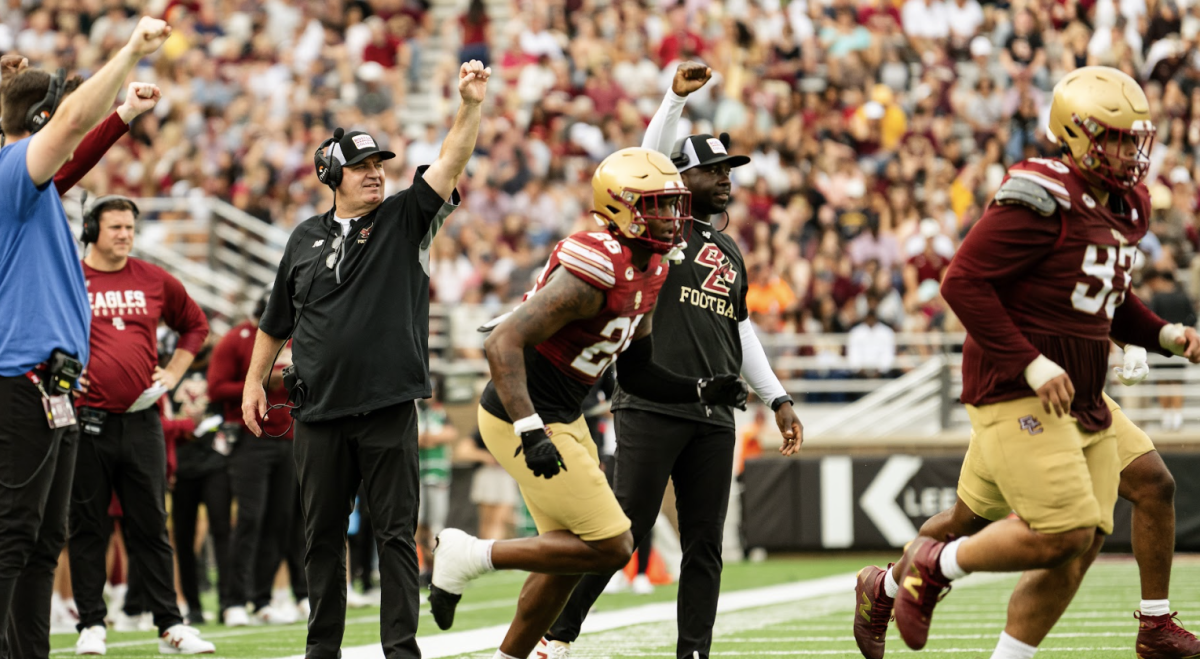Thirty minutes into Boston College women’s soccer’s game against Temple on Sunday afternoon with the Eagles already a goal to the good, a long run by Gaby Carreiro down the left wing ended with the ball being deflected for a corner kick. Sam Coffey immediately headed for the corner flag, knowing the Eagles had a huge opportunity to add to their lead. And add to it they did. In what is rapidly becoming a trademark BC play, the Eagles sent Gianna Mitchell, one of the tallest players on BC’s roster, to crowd Owls goalkeeper Jordan Nash. The resulting service found Kayla Jennings, whose bullet header sailed into the top-corner of the cage, a scoring play that eventually proved to be the winning goal in the Eagles’ 4-1 victory.
This set piece excellently encapsulates BC’s season thus far. The Eagles have rattled off eight-consecutive wins—all non-conference—to start the year, thanks to a combination of superb wing play, shutdown defense, and exquisite strategy. At times, they’ve been outplayed, like when they were outshot, 19-8, in their narrow 1-0 win over then-No. 21 Texas Tech, but their winning formula has yet to let them down. The question that naturally arises, however, is whether this a playing style that can keep bringing them success. So what do the numbers say about BC’s chances to keep its hot start to the season going?
Perhaps the most common of sports cliches is that “defense wins championships.” The good news for the Eagles is that so far this season, they’ve displayed some championship level defensive ability. BC has allowed just three goals in eight games, or 0.38 goals per game. In the 2017 season, that number would have been seventh best in the country, just behind national champion Stanford (0.36 goals per game allowed) and ACC powerhouse Duke (0.38)—a team that fell to UCLA in the Final Four.
For some further context, in 2017 the Eagles’ current goals-against average would have been almost a full goal lower than the national average, 1.34. Go back one season further, that number would have been good for second best in the country and once again well below the national average of 1.39. Of course, it is important to remember that the 2016 team, one that was also undefeated throughout non-conference action, conceded just 0.44 goals per game in non-conference contests. That team struggled once ACC play started, giving up 19 goals in 10 matches and finishing the conference slate 3-7. BC’s excellent goals-against average is not the only number that paints them as an elite defense, however.

Impressively, BC is outshooting opponents, 130-61, on the season, and has allowed just 4.9 percent of opponents’ chances to be converted into goals. To put that figure in perspective, top professional soccer players worldwide such as Chelsea’s Eden Hazard (who scored 17 percent of his shots during the 2017-18 season) expect to turn roughly 15 percent of their chances into goals. In addition, the Eagles have yet to allow a single goal off a set piece in 2018. Free kicks are the hardest plays in soccer to defend and it’s a mark of BC’s defensive solidarity and coaching that it has yet to allow one find the back of the cage.
Any way you slice it, the Eagles are a solid defensive team. They do a great job of limiting shots, and the chances they permit almost never find the back of the net, largely because of Kayla Duran, Alexis Bryant, and Co. The real question, though, is if the Eagles have the offensive firepower to complement a rock solid back line.
BC isn’t lacking goals by any stretch of the imagination. It’s tallied 21 for an average of 2.63 per game, a figure which would again have slotted the program in the top 10 in the country a season ago. That said, there are two things to be noted about that figure.
Over half of those goals—13-of-21 to be exact—came in three games: five against Albany and four against both Quinnipiac and Temple. More notably, BC has scored 11 of those goals off set pieces—seven corner kicks, two direct free kicks, and two penalties. Now, every team has its good days, and even if you remove BC’s three-highest scoring efforts, it still averages 1.6 goals per game, which profiles as an above average offensive attack when considering the national average a year ago was roughly 1.35 goals per game.

The concern about the sustainability of BC’s scoring comes from their set-piece—and specifically corner kick—scoring rates. The Eagles have taken 49 corner kicks, 27 more than their opponents, this season, and scored seven, for a conversion rate of just over 14 percent. It doesn’t take a lot of watching soccer to figure out that the average team doesn’t score almost 15 percent of its corners. In fact, the MIT Sloan Sports Conference estimates that a soccer team has roughly a 2 percent chance of scoring on any given corner. Thus, it’s not unexpected, and it is in fact likely, that BC’s scoring output off of set plays will regress towards the mean.
And therein lies the concern as BC moves into conference play. Against the more prolific attacks in the ACC, the Eagles will not be able to solely rely on a sturdy defense. Somehow, some way, the Eagles will have to make a dent on the scorecard. They’ve gone to set plays to bolster a sometimes-inconsistent attack, but as their scoring rate off free kicks regresses, they’ll need to find more consistent sources of offense. To do this, they’ll likely look to Coffey and Olivia Vaughn—who boast five goals apiece—to keep producing, but will almost certainly need their other offensive weapons such as Jenna Bike, Carreiro, and Carly Leipzig to step up.
Despite an expected dip in set-piece scoring, BC’s winning formula still has mathematical merit. Given the nature of the Eagles’ offense, it stands to reason that the chances of scoring a goal are maximized when taking a set piece.
This was confirmed by the Sloan Sports Conference. In the aforementioned article, it was noted that a teams’ chances of scoring a given set piece are roughly double its chances of scoring a given open play attack—1.8 percent to 1.1 percent. While a 0.7 percent difference may not seem like much, in a sport like soccer that is often low-scoring, every little advantage helps. Thus, BC’s accumulation of corner kicks—an average of 6.1 per game—is a huge boost.
With innovative set pieces and an elite defense, BC appears to have cracked the code for challenging traditional conference powerhouses, such as Duke and North Carolina. Only time will tell if the Eagles’ hot start will continue into ACC play, but the odds seem to be in their favor.
Featured Image by Maggie DiPatri / Heights Staff
Graphics by Peter Kim / Heights Editor













